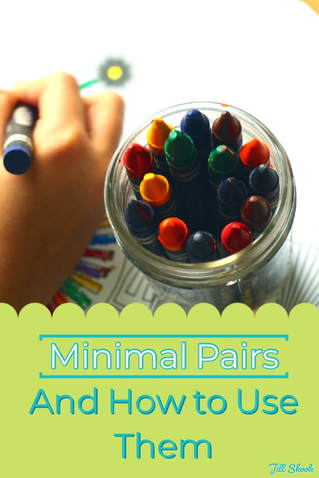|
If you've been an SLP for any amount of time, or if you have a child in speech therapy, chances are that you've heard about minimal pairs. You might think, "What makes them minimal?" or "How could something called 'minimal' help with speech?" I happen to love using minimal pairs in therapy, and I'll show you why. The basics: minimal pairs are words that differ in only one phonological element (sound). Some examples are seat/sheet (initial sound) or back/bat (final sound). Now, on to some reasons that I love them. 1. They're evidence-based According to the venerable SLP gurus Barbara Hodson and Elaine Paden (1), "the use of auditory bobardment, minimal pairs for semantic understanding of speech errors, and gradual multisensory cue fading improved children's overall speech intelligiblity. " In simple terms, that means that using a lot of sound repetitions for the student to listen to, along with minimal pairs and different cues (pointing to your own lips to show shape and use, verbally cuing where to place the articulators to make the sound, drawing pictures, tracing the sound as you say it, etc) help students sound more intelligible. 2. They sneak in some rhyming practice By definition, minimal pairs are words that differ in only one phonological element. So unless you're working on final consonants or final sounds, the words generally rhyme (torn/corn, tape/cape, seat/sheet, etc). I like to point this out when I'm working with kiddos to help them tune in to the sounds of the word. Sometimes I give older students multiple words and have them figure out which ones are the minimal pairs. We work on speech sounds AND phonological awareness, all at once! 3. They're fun There are a ton of fun activities targeting minimal pairs out there! You can also make your own using flash cards, although you need a lot of them. Some of my favorite activities are:
These are my favorite activities to target minimal pairs. Do you have any favorites to add? Tell me in the comments! References:
3 Comments
T
8/30/2020 12:31:17 pm
"sh" is not an affricate. Be careful with examples.
Reply
9/13/2022 03:16:03 am
Thank you for taking the time to share this with us
Reply
Leave a Reply. |
About MEI'm Jill! I love to create and blog about fun, evidence-based resources that make the lives of parents and busy SLPs easier.
�
Archives
February 2018
Categories
All
|


 RSS Feed
RSS Feed